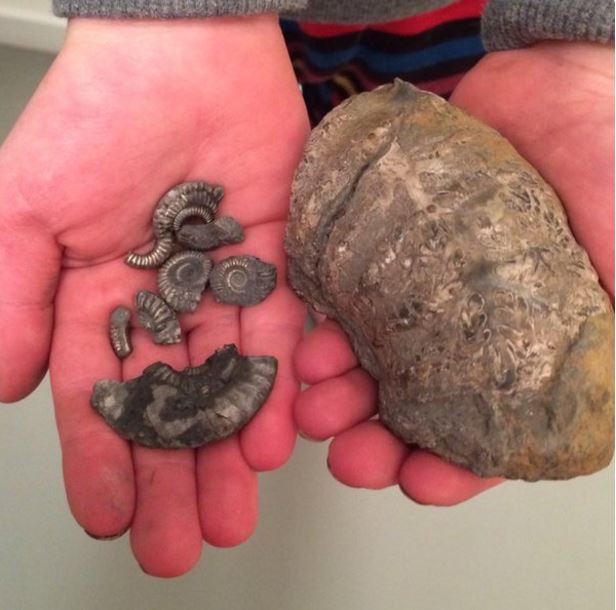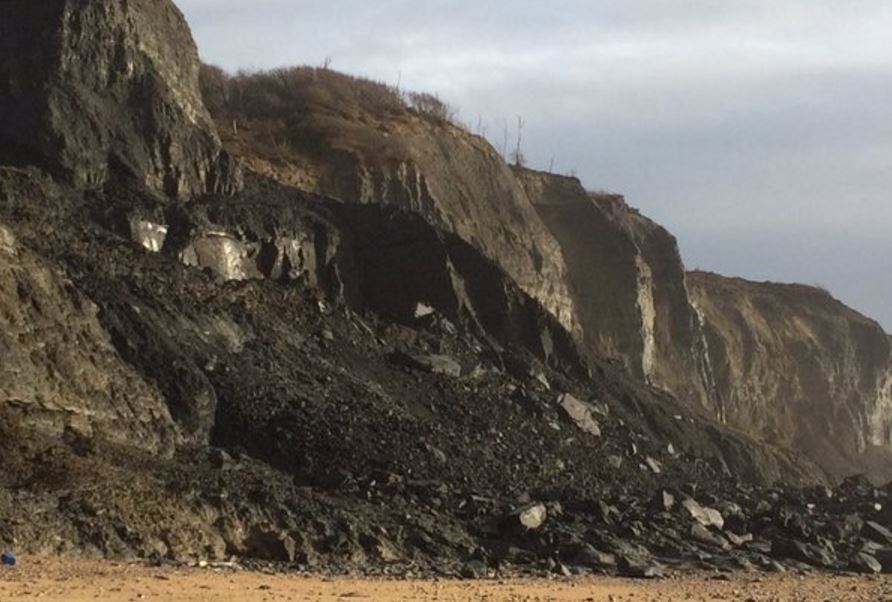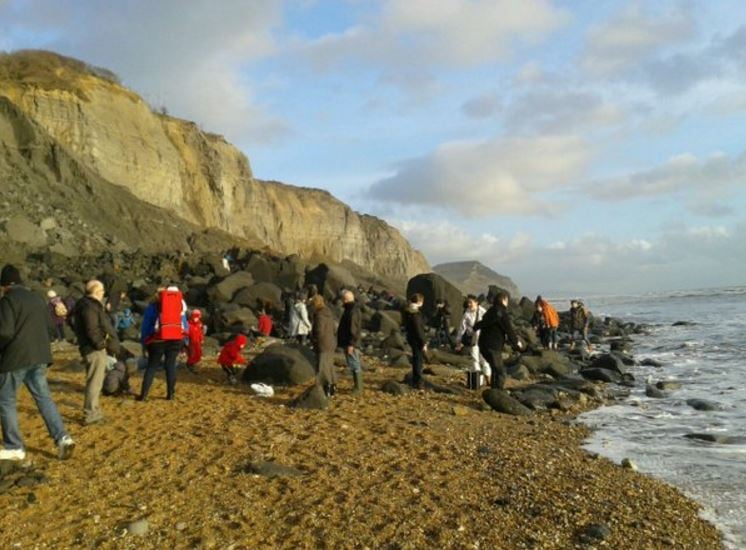It’s fossils galore at Charmouth, a West Dorset village on the Jurassic Coast, after a major cliff fall, which keen collectors know means the beach is currently full of interesting specimens. Landslides and mudflows are common occurrences at the Charmouth cliffs, which are made of several layers of silt, soft mud and clay.
After the recent heavy rains, this most recent cliff fall is considerably greater than most previous ones, local fossil shop owners say.
Charmouth is at the mouth of the River Char, and is on an ancient coastline of spectacular cliffs, beautiful scenery, and lots of fossils.
 Jessie Childs tweeted about her daughter’s super specimens after a fossil-hunting outing at Charmouth, and posted this picture. (Image: twitter.com/childs_jessie)
Jessie Childs tweeted about her daughter’s super specimens after a fossil-hunting outing at Charmouth, and posted this picture. (Image: twitter.com/childs_jessie)
The area is famous for its guided fossil hunting walks along the Jurassic Coast World Heritage Site.
Major cliff fall at Charmouth
When locals walked along the beach a week before Christmas, they could see something very different had occurred. Many say it is the largest cliff fall they have ever seen.
As the news started to spread, scores of people started visiting the area and climbing over the landslip in search of fossils.
Authorities warn visitors not to go near the cliff face, not to climb on mudflows and landslides, nor hammer or dig into the landslides, mudflows or cliff face. Following the recent heavy rains, the cliff areas have become even more hazardous.
Tony Gill, who owns the Charmouth Fossil Shop, told the Western Morning News “Now we need the tide to come in and wash the clay.”
The vast majority of fossils people find in the area are of an extinct group of marine mollusks called ammonites. Most of them are quite small, measuring just a few inches, but now and again you might come across a two-foot-wide specimen.
 Children love fossil hunting on the beach, especially when they come across something interesting. (Image: discoveringfossils.co.uk)
Children love fossil hunting on the beach, especially when they come across something interesting. (Image: discoveringfossils.co.uk)
Regarding finding a big fossil, Mr. Gill said:
“Finding a big one is like one in a thousand. Some of the blocks are as big as cars and may take up to a couple of years to properly wash away.”
The cliffs took millions of years to form
The Charmouth Heritage Coast Centre says the cliffs, which consists of many layers of clay, silt and soft mud, have accumulated one on top of the other over many millions of years.
The cliffs are classified as ‘Sedimentary Rocks’. Sedimentary rocks are formed by sediment, usually brought by rivers, that is deposited over time. The layers are generally formed at the bottom of oceans and lakes. These sediments can include tiny pieces of plants, minerals and other organic matter.
 Many Charmouth locals say it is the largest landslip they have ever seen. (Image: twitter.com/Greg1954)
Many Charmouth locals say it is the largest landslip they have ever seen. (Image: twitter.com/Greg1954)
The sediment is compressed over millions of years before consolidating into solid layers of rock. The layers are called ‘strata’, and are often visible on the sides of exposed cliffs.
The Charmouth cliffs formed at the bottom of a calm sea about 195 million years ago, during the Early Jurassic, and consist mainly of limestone, clay and mud.
Near to the cliff tops, the rocks change colour from a dark grey to a golden yellow. This top Cretaceous (between Jurassic and Tertiary) layer sits on top of an unconformity, a time gap where the rock records have worn away.
Rob Rhodes, National Trust Countryside Manager, said:
“Many millions of years ago Charmouth beach was a tropical sea and salt marsh. As animals died they fell to the bottom of the sea and were fossilised. Since then the land has moved and the rock that makes up the cliffs was once the rock of the sea floor.”
 As soon as the word got out that there were rich pickings to be had, the whole area started filling up with amateur prospectors. (Image: twitter.com/culturediver)
As soon as the word got out that there were rich pickings to be had, the whole area started filling up with amateur prospectors. (Image: twitter.com/culturediver)
“These cliffs are easily eroded by the sea, which washes away the soft rock to reveal hidden fossils of the creatures that once roamed these shores. You can literally pick the fossils up as you walk on the shore.”
Jurassic Coast World Heritage Team leader, Sam Rose, said this latest landslide is ‘fairly typical’ for Charmouth. He warned that it is big enough to ‘trap people by the tide.’ Walking over the mud would be extremely unsafe for those who get stuck in it, or might be cut off by the tide, he added.
Mr. Rose said:
“If people are going to hunt for fossils, they should stay around the edges. It is actually a lot easier and safer to look for fossils on the beach where the sea has done a lot of the work for you by breaking it all up.”
Video – Collecting fossils at Charmouth
People who collect fossils for a living and sell them at their shops in Charmouth talk about the hours they spend seaching around the shores of Charmouth.
